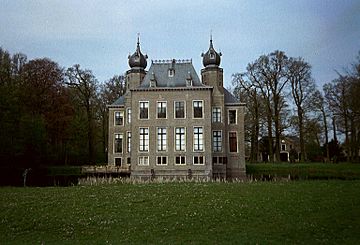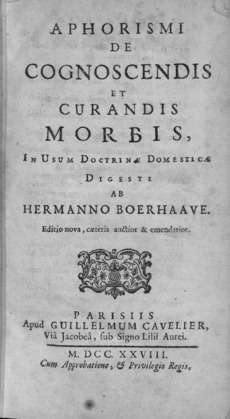Herman Boerhaave facts for kids
Quick facts for kids
Herman Boerhaave
|
|
|---|---|
 |
|
| Born | 31 December 1668 |
| Died | 23 September 1738 (aged 69) Leiden, Dutch Republic
|
| Nationality | Dutch |
| Education | University of Leiden (M.A., 1690) University of Harderwijk (M.D., 1693) |
| Known for | Founder of clinical teaching |
| Scientific career | |
| Fields | Medicine |
| Institutions | University of Leiden |
| Academic advisors | Burchard de Volder |
| Notable students | Gerard van Swieten |
| Author abbrev. (botany) | Boerh. |
Herman Boerhaave (born December 31, 1668 – died September 23, 1738) was a famous Dutch scientist. He was a botanist, chemist, and physician. People from all over Europe knew him.
Boerhaave is known for starting "clinical teaching." This means teaching medicine by showing students how to care for real patients. He also helped create the modern academic hospital. Some even call him "the father of physiology," which is the study of how the body works.
He was one of the first to use numbers and measurements in medicine. He also showed how symptoms (what a patient feels) are connected to lesions (damage inside the body). Boerhaave was the first to find the chemical urea in urine. He also used thermometers to check patients' temperatures, which was new at the time. His motto was Simplex sigillum veri, meaning 'Simplicity is the sign of the truth'. Many called him the "Dutch Hippocrates," after a very famous ancient Greek doctor.
Contents
Herman Boerhaave's Life Story
Herman Boerhaave was born in Voorhout, a town near Leiden in the Netherlands. His father was a Protestant pastor. When he was young, Boerhaave studied to become a preacher. He wanted to work in religion.
After his father passed away, Boerhaave received a scholarship. He then went to the University of Leiden. In 1690, he earned his master's degree in philosophy. His main paper was about "the difference between the mind and the body." In this paper, he disagreed with the ideas of some famous thinkers like Epicurus and Baruch Spinoza.
After studying philosophy, he decided to study medicine. In 1693, he earned his medical doctorate from the University of Harderwijk. His paper for this degree was about "the usefulness of checking signs of disease in sick people's waste."
Teaching and Research at Leiden University
In 1701, Boerhaave became a lecturer at Leiden University. He taught about the basic rules of medicine. In his first speech, he told his students to follow the example of Hippocrates, the great ancient physician.
In 1709, he became a professor of botany (the study of plants) and medicine. He greatly improved the botanic garden of Leiden University. He also wrote many books describing new types of plants.
On September 14, 1710, Boerhaave married Maria Drolenvaux. Her father was a wealthy merchant. They had four children, but only one daughter, Maria Joanna, lived to be an adult. In 1722, he became very sick with gout, but he got better the next year.
In 1714, he became the head of the university. He also took over the practical medicine department. Here, he started the modern way of teaching medicine in clinics. This meant students learned by working with real patients. Four years later, he also became the chemistry professor.
In 1728, he was chosen to be a member of the French Academy of Sciences. Two years later, he joined the Royal Society of London. In 1729, his health got worse. He had to stop teaching chemistry and botany. He died in Leiden after a long illness.
Herman Boerhaave's Lasting Impact
Boerhaave's fame made the University of Leiden very popular. Many people came from all over Europe to study medicine there. Princes from different countries sent their students to him. They found him to be a tireless teacher and a caring guide.
Peter the Great, the Russian emperor, visited Boerhaave in 1716. Famous thinkers like Voltaire and Carl Linnaeus also came to see him. Linnaeus became a close friend and even named a plant group, Boerhavia, after him. Boerhaave's fame reached far beyond Europe. A Chinese official once sent him a letter addressed to "the famous Boerhaave, physician in Europe," and it reached him!
The operating room where Boerhaave once worked is now a museum. It is called the Boerhaave Museum. An Asteroid (a small rocky body in space) is also named after him: 8175 Boerhaave. From 1955 to 1961, his picture was on Dutch 20-guilder banknotes. The Leiden University Medical Centre still holds medical training courses called Boerhaave-courses.
Boerhaave had a huge impact on medicine and chemistry in Scotland. Many of the first teachers at the Edinburgh Medical School had studied with him. They learned from his chemistry lectures. His book Elementa Chemiae (1732) is known as the first important textbook on chemistry.
Boerhaave was the first to describe Boerhaave syndrome. This is a serious condition where the tube connecting the mouth to the stomach (the esophagus) tears. It often happens after very strong vomiting. In 1724, he described a case of a Dutch admiral who died from this after eating too much. Before modern surgery, this condition was always deadly.
Boerhaave was a very religious Christian. He often wrote about God in his works. He saw nature as God's creation. He used to say that poor patients were his best patients because God would pay him back.
Boerhaave's Medical Discoveries
Boerhaave studied the human body very closely. He was influenced by ideas that saw the body like a machine. These ideas came from thinkers like René Descartes and Giovanni Borelli. Borelli described how animals move using mechanical ideas.
Boerhaave thought of the human body as a hydraulic system. This means he saw it working like pipes and pumps. His writings talk about simple machines like levers. He saw body parts as being made of pipe-like structures. For example, he compared veins to pipes.
He believed it was important for body fluids to move freely. There should be no blockages. He also thought the body needed to control itself to stay healthy. Boerhaave's idea of the body as a machine helped focus medicine on physical problems. It moved away from older, mysterious ideas about illness.
New Ways of Teaching Medicine
Boerhaave's teaching brought many students to the University of Leiden. He stressed how important it was to study anatomy (the body's structure). He believed in learning through observation and scientific experiments. His ideas about the body spread across Europe. They helped change how medicine was taught in European schools.
His ideas interested other medical thinkers. One was Friedrich Hoffmann. He also believed in physical and mechanical rules for staying healthy. As a professor at Leiden, Boerhaave taught many students. Some continued his ideas in their own experiments. Others disagreed and suggested new theories.
Boerhaave wrote many textbooks. These books shared his brilliant lectures from Leiden all over Europe. In 1708, his book Institutiones Medicae was published. It was translated into over five languages and had about ten editions. His Elementa Chemia, a world-famous chemistry textbook, came out in 1732.
Boerhaave's idea of the body as a machine was a big change. It moved away from old teachings by Galen and Aristotle. Instead of just following ancient ideas, Boerhaave believed in finding facts through his own research. He used his own testing methods. This new way of thinking helped improve medical practice. It also led to new understandings in the field of iatrochemistry (the use of chemistry in medicine).
Images for kids
See also
 In Spanish: Herman Boerhaave para niños
In Spanish: Herman Boerhaave para niños






